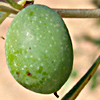The Olive Tree in its wild form is a short evergreen tree. Domesticated olive is a tree with a broad crown and broad trunk and long-lived. Some say that ancient trees in Israel are 2000 years old, but it seems that such statement is unfounded and exaggerated. The center of the trunk of old olive trees is always hollow due to natural decay. It is therefore impossible to determine the tree's age using common scientific methods. Archeological remains indicate that olives were grown in Israel already in the fourth millennium BCE, during the Chalcolithic period. Pollen of wild olives was found in sediments from 30,000 years ago. Remains of olive wood were found in layers from 45,000 years ago in the Negev Highlands, which indicates that the climate was different at that time.
The tree grows shoots from the base of the trunk. Some claim that it is possible to distinguish between domesticated and wild olives by the shape of these shoots; in the wild trees the branch is ribbed and thorny and the leaf is ovate and short, and the fruit is small and oil-poor. The thorns are especially prominent in the young plants and lower branches and disappear as the tree grows.
The leaf of the domesticated olive is leathery, simple, lanceolate, its margins are entire and bent downwards. Its lower side is silvery, its upper side is dark green (olive green). The leaf persists for 3 years. The leaves are opposite. Olive wood is good for carving ornamental objects. The trunk of old trees is usually hollow and the shoots that grow around the base fuse with the trunk and make its shape irregular.
The olive is one of the seven kinds (of crops) with which the Land of Israel was blessed already in antiquity, and its cultivation fulfilled an important role in the economy and culture of the Land of Israel for thousands of years. Its cultivation in Israel is extensive and ancient, and today it is difficult to determine which tree is wild and which is a tree that escaped from domestication, if there are any wild olives growing in Israel at all.
Olea europaea blooms in April-May. The flowers are arranged in inflorescences on branches from the previous year. The flower is small, greenish to white-yellowish, is not prominent, but emits a scent. It is pollinated by insects which seek the pollen or by wind. Pollination is usually by different trees, due to self-incompatibility (the pollen will not successfully fertilize stigmata of a flower on the same individual). The flower has 4 tiny tooth-like sepals, 4 corolla lobes and two stamens. The petals are twisted while still a bud. The stamens are connected at their base to the petals. The fruit ripens beginning in September. It includes a fatty fleshy pulp and a very hard stone with a single seed. The pulp is bitter and is eaten only after a prolonged process of curing. The fruit is green at first, and later turns black and shiny. The green olive is unripe, and is used for curing “green olives”. The ripe olive is black, and is eaten as “black olives” as well as for production of oil. The green fruit contains 10 to 15 percent oil, and the black fruit contains 20 to 38 percent oil.
Olive oil is considered the highest quality and healthiest of the edible oils, and the demand for olive oil increases from year to year in Israel and globally, with the increase in awareness for health and the rise in the standard of living. In addition to food, olive oil is also used for illumination (a use that is gradually decreasing), for cosmetics and for production of soap. Olive oil has many uses in folk medicine, both for external and internal uses.
Olives are grown worldwide in the subtropical latitudes, between 30 and 45 degrees north. The main production countries are the North Mediterranean peninsulas: Asia Minor, the Balkans, Italy and Spain. The olive groves of the Greek Island of Corfu became famous through Gerald Durrell’s book My Family and Other Animals.
Olea europaea grows wild in Maquis and rocks in rocky habitats of hard karstic limestone or dolomite. It is common mainly in the north of the Mediterranean mountain range at low altitude (up to 600 m), especially on Mount Carmel and the Western Upper Galilee.
The yield of the domesticated olive in Israel is variable because of extreme alternations, and ranges from 10 to 50 thousand tons of fruit annually, out of a global yield of 15 million tons. Olive picking is performed by hitting the branches so that the fruit falls, or by milking motions. After years of decline in the areas planted with olives, a sharp increase in planting olive trees has been taking place in Israel in recent years, in the Arab as well as the Jewish sector.
The genus contains 40 species in tropical and temperate-warm regions of Africa, India and Australia. In Israel there is 1 species.
Written by Mike Livne







